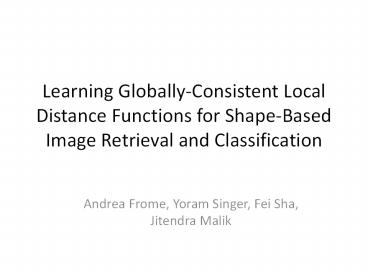Learning Globally-Consistent Local Distance Functions for Shape-Based Image Retrieval and Classification - PowerPoint PPT Presentation
Title:
Learning Globally-Consistent Local Distance Functions for Shape-Based Image Retrieval and Classification
Description:
Learning Globally-Consistent Local Distance Functions for Shape-Based Image Retrieval and Classification Andrea Frome, Yoram Singer, Fei Sha, Jitendra Malik – PowerPoint PPT presentation
Number of Views:182
Avg rating:3.0/5.0
Title: Learning Globally-Consistent Local Distance Functions for Shape-Based Image Retrieval and Classification
1
Learning Globally-Consistent Local Distance
Functions for Shape-Based Image Retrieval and
Classification
- Andrea Frome, Yoram Singer, Fei Sha, Jitendra
Malik
2
Goal
3
Nearest neighbor classification
D ( , )
4
Nearest neighbor classification
D ( , )
5
Learning a Distance Metric from Relative
Comparisons
Schulz Joachims, NIPS 03
( - )T
6
(No Transcript)
7
Approach
image i
image j
8
Approach
image i
dji,m
image j
9
Approach
image i
Dji S wj,mdji,m
image j
10
Approach
image i
lt
Dki
Dji
image j
11
Core
wj,m ?
image j
12
Derivations
- Notation
- Large-margin formulation
- Dual problem
- Solution
13
Notations
for triplet i, j, k
14
Large-margin formulation
15
SVM
16
SVM
17
SVM
18
SVM
19
Soft-margin SVM
20
Derivation
21
Dual
22
Details Features and descriptors
- Find 400 features per image
- Compute geometric blur descriptor
23
Descriptors
- Geometric blur
24
Descriptors
- Two sizes of geometric blur (42 pixels and 70
pixels) - Each is 204 dimensions (4 orientations and 51
samples each) - HSV histograms of 42-pixel patches
25
Choosing triplets
- Caltech101 at 15 images per class
- 31.8 million triplets
- Many are easy to satisfy
- For each image j, for each feature
- Find the N images I with closest features
- For each negative example i in I, form triplets
(j, k, i) - Eliminates half of triplets
26
Choosing C
27
Choosing C
- Train with multiple values of C, testing on a
held-out part of the training set - Choose whichever gives the best results
- For each C, run online version of the training
algorithm - Make one sweep through training triplets
- For each misclassified triplet (i,j,k), update
weights for the three images - Choose C which gets the most right answers
28
Results
- At 15 training examples per class 63.2 (3
improvement) - At 20 training examples per class 66.6 (5
improvement)
29
Results
- Confusion matrix
Hardest categories crocodile, cougar_body,
cannon, bass
30
Questions
- Is there any disadvantage to a non-metric
distance function? - Could the images be embedded in a metric space?
- Why not learn everything?
- Include a feature for each image pixel
- Include multiple types of descriptors
- Could this be used for to do unsupervised
learning for sets of tagged images (e.g., for
image segmentation)? - Can you learn a single distance per class?































